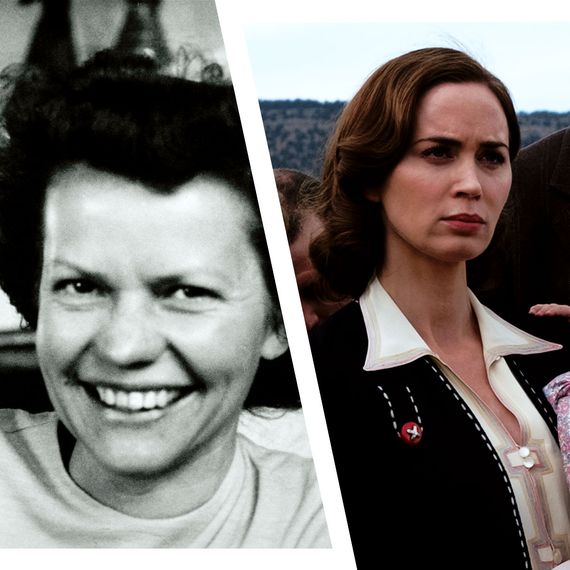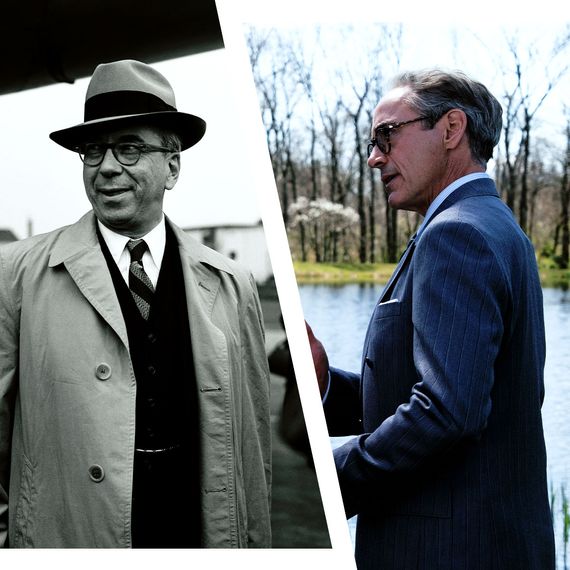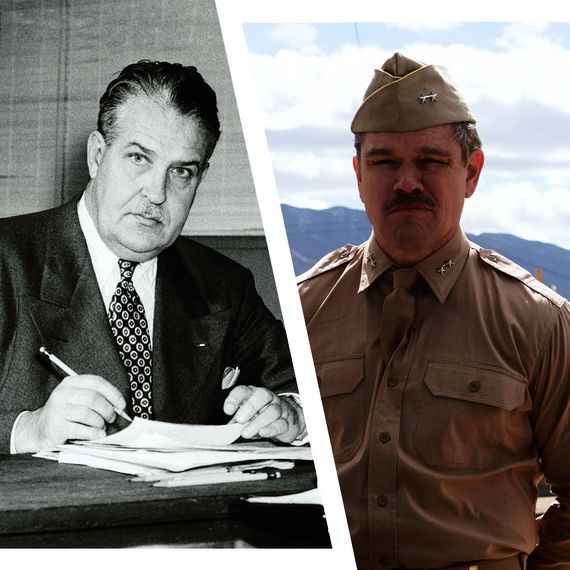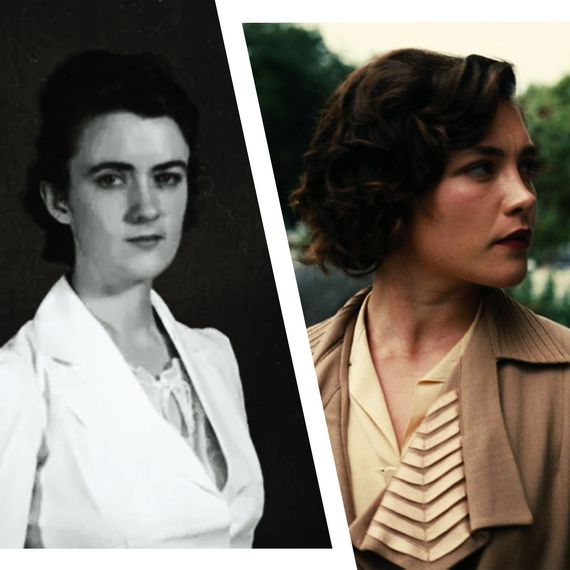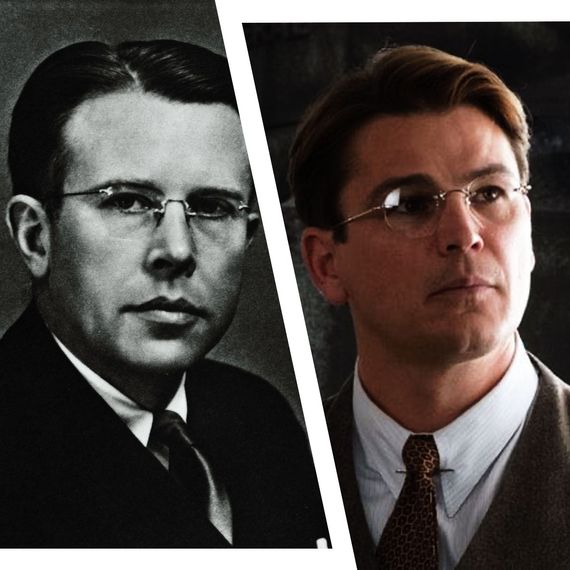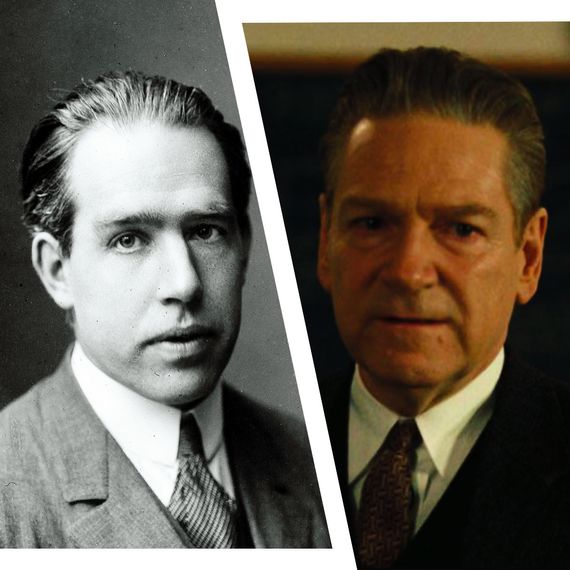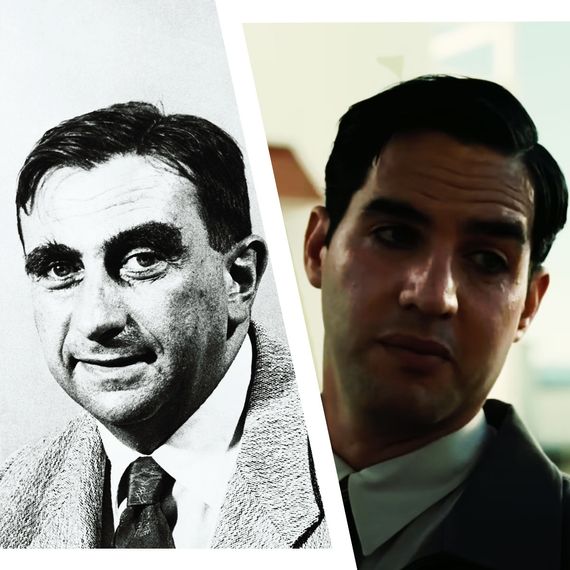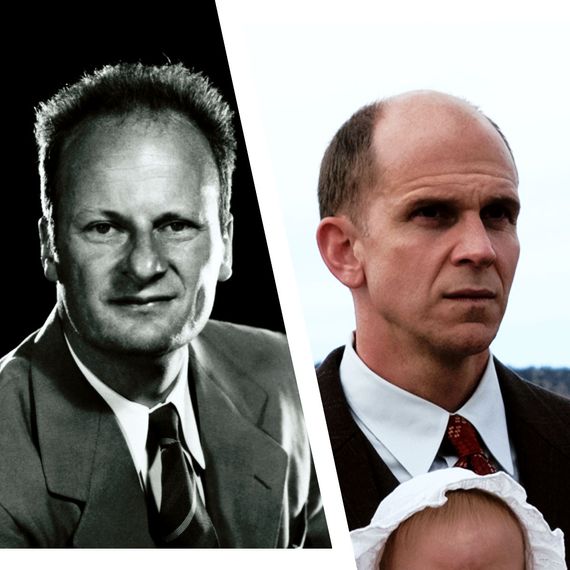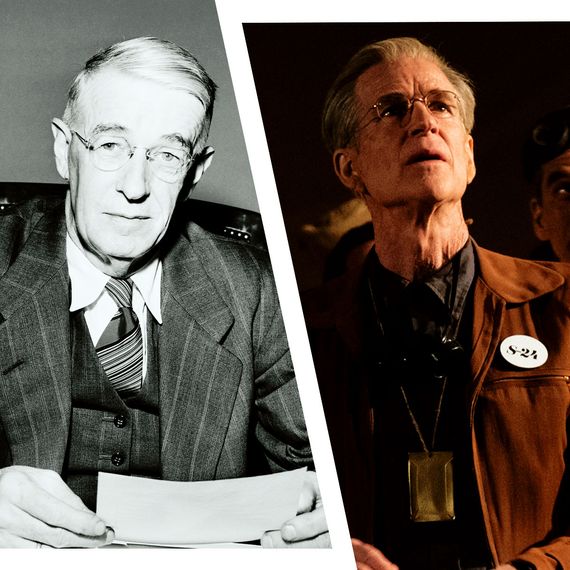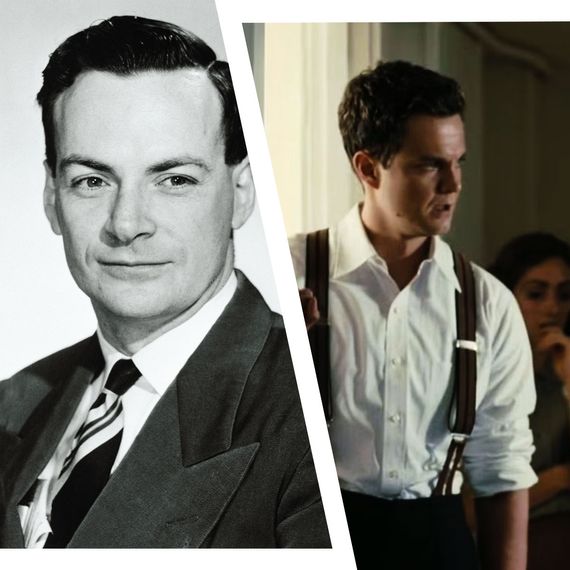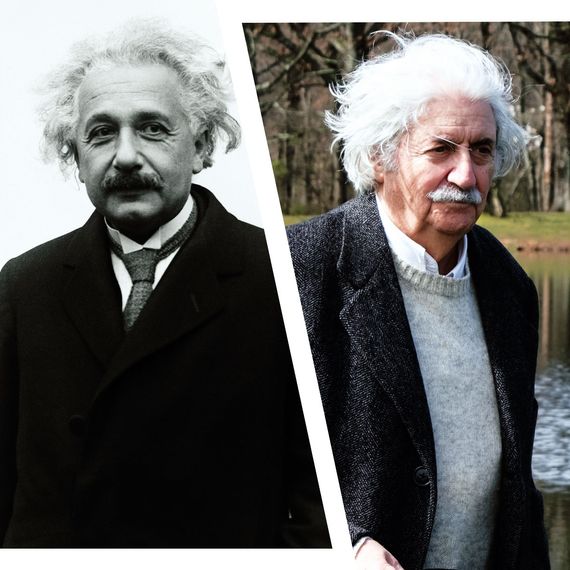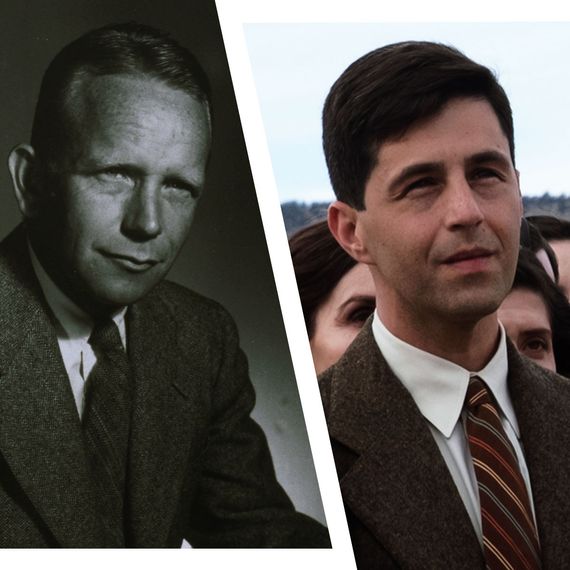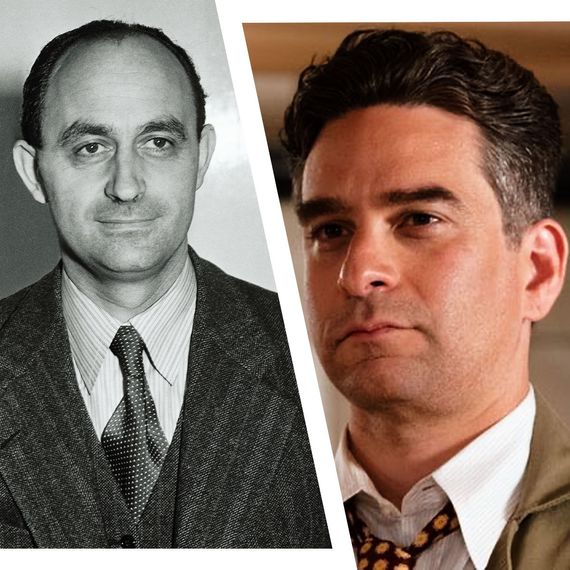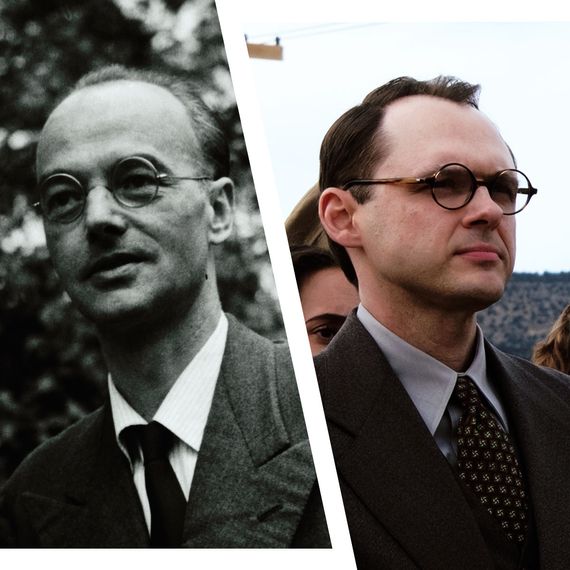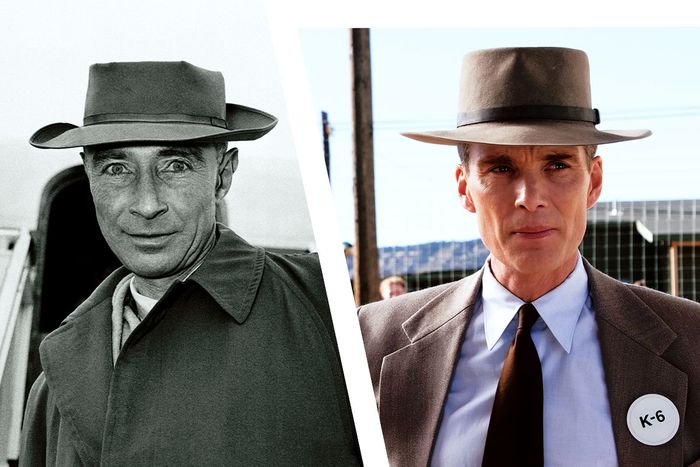
If you aren’t Tom Cruise, chances are you have a role in either Greta Gerwig’s Barbie or its July 21 rival, Christopher Nolan’s Oppenheimer, a sprawling, three-hour biopic about the creator of the atomic bomb. Together, the Barbie and Oppenheimer ensembles represent about 503 percent of SAG-AFTRA’s voting members, who are currently on strike for better labor conditions. But while it isn’t hard to figure out who’s playing who in Gerwig’s candy-colored romp (you’re either a Barbie, a Ken, or the one and only Allan), Nolan’s R-rated World War II drama is a cavalcade of white men in suits exchanging rapid-fire dialogue about physics and war.
The film is based on Kai Bird and Martin J. Sherwin’s American Prometheus: The Triumph and Tragedy of J. Robert Oppenheimer, an in-depth biography of Oppenheimer’s life that took over 20 years to complete, though Nolan also uses several governmental transcripts as direct sources. Set over several decades, this cinematic saga of politics and nuclear war demands an enormous cast of actors playing either scientists who worked on the Manhattan Project, Oppenheimer’s friends and lovers, government officials who helped or hindered him, and members of America’s Communist Party.
In situations like these, it helps to start with the title character:
Cillian Murphy as J. Robert Oppenheimer
Julius Robert Oppenheimer, who often went by Robert or “Oppie,” is better known to most as the father of the atomic bomb. Born to a non-observing Jewish family in New York, Oppenheimer would spend the first half of the 20th century making numerous breakthroughs in physics (including the earliest black hole theory) before working on the Manhattan Project, which resulted in the United States dropping nuclear bombs on Hiroshima and Nagasaki. The film covers not only World War II but Oppenheimer’s 1954 security hearing by the Atomic Energy Commission, motivated in part by McCarthyist investigations into his left-wing, pro-union political leanings and suspected communist ties. It also didn’t help that Oppenheimer’s frequent womanizing led him to associate with several women who were, at one time or another, members of the Communist Party of America, placing the famous physicist under even further Red Scare scrutiny.
Oppenheimer is played by Nolan’s go-to gaunt supporting actor, Cillian Murphy, now bumped up to leading man after his appearances in Inception, Dunkirk, and The Dark Knight Trilogy.
Emily Blunt as Katherine “Kitty” Oppenheimer
Oppenheimer’s wife at the time of his death in 1967, the German-born Katherine “Kitty” Oppenheimer first met the famous scientist in 1939 while she was still married to her third husband. Her first marriage had been annulled in just under a year, while her second common-law husband was killed in action during the Spanish Civil War in 1937 while fighting as part of the Mackenzie–Papineau Battalion, composed of Canadian and American volunteers supporting the Republican faction. Like several of Oppenheimer’s associates, Kitty was a member of the Communist Party of America, though, in both the film and in the transcript of Oppenheimer’s hearings, she claims to have left the party prior to meeting him.
Robert Downey Jr. as Lewis Strauss
The chairman of the U.S. Atomic Energy Commission in the 1950s, Lewis Strauss had an adversarial relationship with Oppenheimer. This took the form of ideological and political disagreements — the left-leaning Oppenheimer opposed building the hydrogen bomb, which the Republican Strauss sought to move ahead with — but there was also personal animosity between them after Oppenheimer mocked Strauss in a public hearing about the risks posed by exporting radioisotopes. This eventually resulted in the Strauss-backed 1954 hearings to revoke Oppenheimer’s security clearance, which would eventually come up during Strauss’s 1959 confirmation hearing for the position of U.S. Secretary of Commerce.
Also, fun fact: This is Downey Jr.’s first onscreen role since Dolittle in 2020.
Matt Damon as Leslie Groves
After overseeing the creation of the Pentagon, lieutenant general (then brigadier general) Leslie Groves was tasked with directing the Manhattan Project in 1942. He was responsible for appointing Oppenheimer as its scientific-research coordinator and even circumvented the government’s concerns about his communist associations in order to fast-track his security clearance. Together, they chose the Los Alamos, New Mexico, location for the project and the eventual Trinity test, the first-ever detonation of a nuclear bomb. In the years that followed, Groves maintained his admiration for Oppenheimer, calling him a good man.
Florence Pugh as Jean Tatlock
Oppenheimer’s girlfriend and eventual mistress, Jean Tatlock began her tumultuous relationship with him in 1936, and as a member of the Communist Party, she’s widely believed to be responsible for introducing him to radical politics. Their relationship continued after Oppenheimer’s marriage to Kitty, though the clinically depressed Tatlock would eventually die by suicide at the age of 29. It’s also believed that Oppenheimer named the Trinity test in tribute to her since she had introduced him to the poems of John Donne, whose sonnet “Batter my heart, three-person’d God” was the likely inspiration for the name.
Dylan Arnold as Frank Oppenheimer and Emma Dumont as Jackie Oppenheimer
Frank, Oppenheimer’s younger brother by eight years, would follow in his big bro’s footsteps, becoming not only a physicist but a member of the Manhattan Project. He also shared Oppenheimer’s leftist political beliefs and, along with his wife Jackie, joined the Communist Party, though he did so against Oppenheimer’s advice.
Josh Hartnett as Ernest Lawrence
Another key scientist in the Manhattan Project, Ernest Lawrence met Oppenheimer during their time at the University of California, Berkeley, where he built his Nobel Prize–winning cyclotron, a precursor to the modern particle accelerator. He was close friends with Oppenheimer and he even named his son Robert after him. However, their political disagreements over Oppenheimer’s unionizing efforts and his brother’s communist leanings led to a souring of their relationship. Though he declined to testify against his former friend at the 1954 hearings, his critical statements were still used.
Casey Affleck as Boris Pash
A U.S. Army Intelligence officer, Boris Pash was tasked with investigating Oppenheimer (among others) for potential Soviet leanings during the war on the suspicion of leaks from the Berkeley wing of the Manhattan Project. However, when asked to testify in 1954, he was much less doubtful of Oppenheimer’s loyalty than Lewis Strauss was, never believing him to be a spy or recommending that his clearance be revoked. Onscreen, Affleck plays him with an icy cold demeanor, making him seem all the more ruthless.
Máté Haumann as Leo Szilard
The Hungarian-German-American scientist who first conceived of nuclear chain reactions, Leo Szilard became a staunch opponent of using nuclear weapons on civilians. He drafted what would come to be known as the Szilard petition, urging President Harry S. Truman to inform Japan of the Allies’ terms of surrender and to allow them to either accept or refuse those terms before considering the nuclear option.
Kenneth Branagh as Niels Bohr
One of the most prominent scientists of the 20th century, Danish physicist Niels Bohr is the reason we illustrate atoms the way we do (with electrons orbiting a nucleus, like a miniature solar system). Bohr was only briefly involved with the Manhattan Project, though Oppenheimer credits him with significant contributions. In the film, he’s first introduced giving a lecture on quantum physics at Cambridge as an excited young Oppenheimer looks on.
Rami Malek as David Hill
An experimental physicist at the University of Chicago during the Manhattan Project, David Hill was one of 70 scientists who signed the Szilard petition. He also testified at Strauss’s Senate confirmation hearing, accusing him of twisting Oppenheimer’s security hearings into a petty smear campaign.
Benny Safdie as Edward Teller
A fellow Manhattan Project physicist, Hungarian-American Edward Teller had some professional animosity with Oppenheimer over what kind of weapons to prioritize at the Manhattan Project, favoring his idea for a fusion-type weapon, rather than the fission-type one which was eventually used. (Teller referred to the former as “the Super.”) After consulting Oppenheimer, Teller initially refused to sign Szilard’s petition against using the atomic bomb on civilians, though he came to regret his decision in later years. Teller would also go on to be known as the father of the hydrogen bomb, the successor to the atomic bomb, and he would eventually testify against Oppenheimer in 1954. While playing Teller, Safdie can be instantly identified as the sweatiest man in the room.
Gary Oldman as Harry S. Truman
The U.S. president from 1945 to 1953, Harry Truman oversaw the end of World War II and authorized the use of nuclear weapons against Japan. He and Oppenheimer maintained starkly different opinions on nuclear power going forward (Truman was in the pro camp) and their perspectives on Hiroshima and Nagasaki were similarly opposed. In the film, when Oppenheimer expresses his regrets to Truman at a face-to-face meeting, Truman calls him “a crybaby” — an incident based on (alleged) historical fact.
Gustaf Skarsgård as Hans Bethe
A German-American theoretical physicist, Hans Bethe was personally invited to the Manhattan Project by Oppenheimer, and would eventually oversee its T (Theoretical) Division, which calculated the A-bomb’s explosive yield. Bethe had been friends with Edward Teller for several years, but they had numerous major disagreements while working under Oppenheimer over what kind of weapon to approach, leading to the de-prioritizing of Teller’s idea for a fission device, “the Super.”
David Krumholtz as Isidor Isaac Rabi
Another Nobel Prize–winning physicist on the Manhattan Project, the Polish-born, New York-raised Isidor Isaac Rabi met Oppenheimer while the duo studied in Germany in the 1920s. They remained lifelong friends, and Rabi would even testify at Oppenheimer’s hearings in his defense. Krumholtz’s character is the only one who broaches the subject of Oppenheimer’s Judaism with him — a background they share — and he’s always making sure the father of the atomic bomb is well-fed.
Matthew Modine as Vannevar Bush
An inventor and scientific administrator, Vannevar Bush was responsible for communicating Oppenheimer’s work on the Manhattan Project to then-president Roosevelt in 1942. He was also part of the committee that advised Roosevelt’s successor, Truman, on using the atomic bomb against Japan posthaste.
David Dastmalchian as William L. Borden
The executive director of the U.S. Congress Joint Committee on Atomic Energy, William Borden was a huge proponent of nuclear weapons development in the early 1950s, at a time when Oppenheimer was less enthused by the idea. Upon entering the private sector, Borden’s letter to FBI director J. Edgar Hoover, accusing him of being an agent of the Soviet Union, was instrumental in investigating Oppenheimer’s loyalty. In the film, he can mostly be seen compiling his file on Oppenheimer, though he does feature in a brief but memorable flashback in the cockpit of a fighter plane.
Michael Angarano as Robert Serber
Physicist Robert Serber was one of Oppenheimer’s colleagues at Berkeley and was another one of his personal appointees to the Manhattan Project. Serber came up with the code names for each of the bomb projects in development based on their appearance: “Little Boy” (dropped on Hiroshima), “Fat Man” (dropped on Nagasaki), and the unused “Thin Man” design, an enormous plutonium gun.
Jack Quaid as Richard Feynman
Recruited for the Manhattan Project before he’d earned his graduate degree, Richard Feynman became one of the most renowned physicists of the 20th century. He initially had an administrative role on the project, but took on additional responsibilities over time, including devising safety procedures for uranium storage and theoretical calculations for a proposed uranium-hydride bomb (though this would prove unfeasible). His work in quantum electrodynamics would eventually win him a Nobel Prize in 1965. In the film, he can be seen playing the bongos, much as he did in real life.
Dane DeHaan as Kenneth Nichols
An army officer and civil engineer on the Manhattan Project, Kenneth Nichols would eventually provide testimony against Oppenheimer at his 1954 hearings, after becoming the general manager of the Atomic Energy Commission. His accusations that Oppenheimer was a communist and untrustworthy contributed to the commission’s decision to strip him of his security clearance.
Olivia Thirlby as Lilli Hornig
Originally a typist at Los Alamos, scientist Lilli Hornig impressed her Manhattan Project superiors and was eventually brought into the nuclear fold — albeit with limits, since members of the project decided that plutonium chemistry was too dangerous for women (yes, really). In the film, this factoid gets dramatized when Robert Serber voices concerns about the effects of radiation on the female reproductive system. Hornig was also part of the opposition to using the atomic bomb on civilians and signed the Los Alamos scientists’ petition to drop the bomb on an uninhabited island instead.
James Remar as Henry L. Stimson
The U.S. secretary of war from 1911 to 1913, Henry L. Stimson once again resumed the post during World War II. He created the Interim Committee in 1945, a secret, high-level group that liaised with the Manhattan Project on matters of nuclear weaponry, including the proposed targets of the atomic bombs. Of the 12 proposed Japanese cities, he struck Kyoto off the list of potential targets for sentimental reasons, since he and his wife had spent their honeymoon there.
Tom Conti as Albert Einstein
The one person on this list who needs no introduction, Albert Einstein’s name is practically synonymous with genius, but the renowned physicist hadn’t actually considered the possibility of nuclear weapons until he was convinced otherwise in 1939. Shortly thereafter, he signed the Einstein-Szilard letter — along with the very same Szilard who eventually led the demonstration petition — urging then-president Franklin Roosevelt to start a U.S. nuclear program, lest Nazi Germany beat them to it.
Fun fact: Conti plays the kind prisoner who punches Batman’s spine back to health in Nolan’s The Dark Knight Rises.
Jefferson Hall as Haakon Chevalier
A professor of French Literature at Berkeley, Haakon Chevalier was close friends with Oppenheimer and even took in his and Kitty’s infant son Peter for several months so they could spend time together on their ranch. He was believed to be a member of the Communist Party, making his and Oppenheimer’s relationship a key subject of the 1954 hearings, given what came to be known as “the Chevalier incident.” At a party in 1943, Chevalier approached Oppenheimer with information about Soviet attempts to gain intel on the Manhattan Project through a British scientist named George Eltenton (Guy Burnet). When reporting this conversation to his military superiors, Oppenheimer embellished various details to obscure both Chevalier’s identity as well as his own.
Josh Peck as Kenneth Bainbridge
A Harvard physicist, Kenneth Bainbridge was the director of the Trinity test and worked closely with Oppenheimer. His involvement with the Manhattan Project led him to eventually oppose nuclear testing. In Oppenheimer, he’s the guy who pushes the comically large red button to initiate the test.
Jason Clarke as Roger Robb and Macon Blair as Lloyd Garrison
Roger Robb — who would eventually become a U.S. circuit judge — was appointed as special counsel to the Atomic Energy Commission during the Oppenheimer hearings, which were closed and confidential. Lloyd Garrison, meanwhile, was Oppenheimer’s private attorney for the hearings (the duo had met the previous year at Princeton’s Institute for Advanced Study). Where Robb was granted security clearance to review all relevant documents, Garrison was not, making his job of defending Oppenheimer next to impossible.
James D’Arcy as Patrick Blackett
A British experimental physicist, Patrick Blackett was one of Oppenheimer’s professors at Cambridge in the 1920s. Given Oppenheimer’s social inadequacies at the time, he made the more outgoing Blackett the object of his jealousy and attempted to feed him a poisoned apple (a plot that plays out to strange and hilarious effect in the movie). While Blackett had no known involvement with the Manhattan Project, he did serve on Britain’s MAUD Committee, which was formed to determine the feasibility of nuclear weapons.
Danny Deferrari as Enrico Fermi
The creator of the world’s first nuclear reactor, Enrico Fermi was another world-renowned physicist and a late addition to the Manhattan Project in 1944. Along with Oppenheimer and Lawrence, he advised the Interim Committee on potential Japanese targets. After World War II, he worked closely with Oppenheimer on advising the Atomic Energy Commission against the development of hydrogen bombs and spoke in Oppenheimer’s defense at his hearings.
Devon Bostick as Seth Neddermeyer
A physics prodigy who made numerous breakthrough discoveries in his 20s, Seth Neddermeyer made perhaps one of the most impactful contributions to the Manhattan Project, as a strong proponent of the implosion-type reaction the atomic bombs would eventually use. While several of his peers remained initially unconvinced of this method’s plausibility, Oppenheimer placed Neddermeyer in charge of testing and developing it. In the film, he can be seen having an adverse emotional (and physical) reaction after the bombing of Hiroshima.
Alex Wolff as Luis Walter Alvarez
Another eventual Nobel Prize winner, experimental physicist Luis Walter Alvarez worked under Ernest Lawrence at Berkeley. Upon Oppenheimer’s suggestion, he subsequently worked under Enrico Fermi at the University of Chicago before joining the Manhattan Project, and he also helped develop methods to detect nuclear activity in other countries. In the film, he can be seen urgently sprinting out of a barbershop mid-shave to tell Oppenheimer and Lawrence the news that German scientists Otto Hahn and Fritz Strassmann had achieved nuclear fission.
Josh Zuckerman as Giovanni Rossi Lomanitz
After working for Oppenheimer at Berkeley’s radiation lab, Lomanitz would join the Manhattan Project and would eventually become one of the subjects of the Oppenheimer hearings given his ties to the Communist Party. Lomanitz is first introduced in the film as Oppenheimer’s one and only student at Berkeley.
Matthias Schweighöfer as Werner Heisenberg
The namesake of Walter White’s gangster-scientist alter ego in Breaking Bad, German theoretical physicist Werner Heisenberg is often credited as the originator of quantum mechanics. He was a major contributor to Germany’s atomic program during World War II and was subsequently captured by an allied U.S.-Britain mission to retrieve nuclear intelligence and personnel from Germany before the Soviet Union. In the film, Oppenheimer travels to Göttingen to study theory under Heisenberg upon the suggestion of Niels Bohr.
Christopher Denham as Klaus “Karl” Fuchs
A German-born physicist who took refuge in Britain during World War II, Klaus Fuchs — known at Los Alamos as Karl — worked on uranium enrichment for the Manhattan Project while spying for the Soviet Union. The identity of the spy remains a mystery in Oppenheimer until Strauss shares the news with Oppenheimer at a party several years after World War II.
Alden Ehrenreich as a “Senate Aide”
A role that appears to be anonymous (and likely fictitious), Ehrenreich’s Senate Aide serves as the audience POV character for the movie’s black-and-white framing device, which is set during Strauss’s 1959 confirmation hearing.
James Urbaniak as Kurt Gödel
An Austro-Hungarian mathematician and logistician, Kurt Gödel was a close friend of Albert Einstein, whose association with Jewish members of the Vienna Circle placed him under Nazi scrutiny. He was subsequently conscripted to fight for Germany in 1939 but escaped to Princeton instead. In the film, he and Einstein can be seen walking the Princeton grounds when Oppenheimer approaches the latter for advice; Gödel appears only briefly, but leaves an impression with his admiration for trees, which he calls “the perfect structure.”
More on Oppenheimer
- Every Oscar Best Picture Winner, Ranked
- Ryan Gosling and Emily Blunt Break Up with Barbenheimer on SNL
- Fallout Is Barbenheimer: The TV Show


